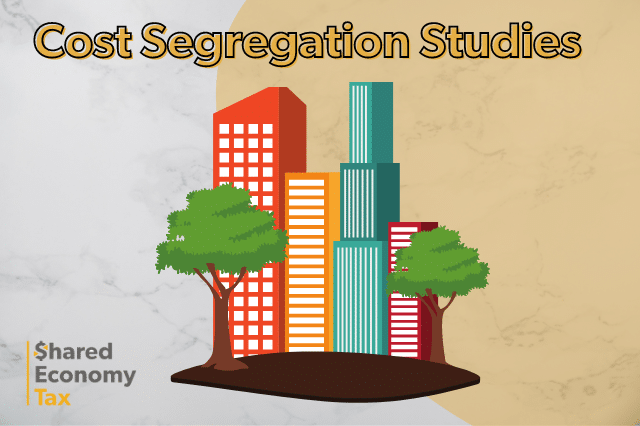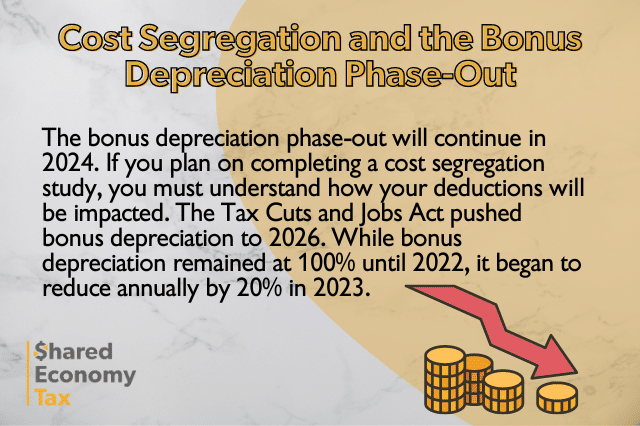
Cost segregation continues to be a powerful tax strategy for real estate investors and Airbnb hosts, enabling them to accelerate depreciation deductions and reduce their taxable income. However, as we move into 2025, there are key updates and strategies that you need to be aware of to make the most of this approach. In this post, we’ll discuss the most recent cost segregation trends and updates, including news on bonus depreciation, changes in the real estate market, and important new legislative developments impacting tax strategies for 2025.
What is Cost Segregation?
Cost segregation is a tax deferral strategy that allows property owners to increase cash flow by accelerating depreciation deductions. By separating the various components of a property, such as personal property, land improvements, and the building itself, a cost segregation study allows you to depreciate the non-structural components at a faster rate, typically over 5, 7, or 15 years instead of the standard 27.5 or 39 years for the building.
The result is an immediate reduction in taxable income, which is particularly beneficial for real estate investors and business owners who want to reinvest those tax savings into new properties or improvements.
Check out our main post on cost segregation to learn more about the process.
How Cost Segregation Helps Airbnb Hosts and Real Estate Investors
Cost segregation is especially useful for Airbnb hosts and real estate investors with high-value properties or multiple investments. By accelerating depreciation, you can reduce your taxable income and boost your cash flow, allowing you to reinvest that money into your next property or improvements to your existing ones. The process works by allocating the building’s purchase price into categories like personal property (which depreciates over a shorter period), land improvements, and the structure itself.For example, an Airbnb host with several rental properties can use cost segregation to speed up depreciation on items such as furniture, appliances, and even certain landscaping features, which can result in significant tax savings in the first few years of ownership.
Cost Segregation Updates for 2025
There are a few major updates to be aware of this year.

Bonus Depreciation Phase-Out
One of the most important developments impacting cost segregation for 2025 is the continued phase-out of bonus depreciation. The Tax Cuts and Jobs Act (TCJA) allowed 100% bonus depreciation for property placed in service through 2022, enabling real estate investors to deduct the full cost of qualifying property upfront. However, this bonus depreciation is gradually reducing over the next few years:
- 2023: 80% bonus depreciation
- 2024: 60% bonus depreciation
- 2025: 40% bonus depreciation
- 2026: 20% bonus depreciation
- 2027: Expiration of bonus depreciation
For 2025, the bonus depreciation is at 40%, meaning investors can only deduct 40% of the property’s purchase price in the first year. While it’s still a significant benefit, it’s important for investors to act quickly before bonus depreciation continues to decrease further. If you have plans to purchase or upgrade investment properties, 2025 could still offer a good opportunity to take advantage of higher first-year deductions.
Real Estate Market and Cost Segregation Considerations
The real estate market in 2025 presents unique challenges and opportunities. As property values remain high and mortgage rates stabilize, real estate investors may face increased borrowing costs, yet there are still strong opportunities for cash flow through strategic cost segregation studies.
For Airbnb hosts with multiple properties or those considering acquiring additional properties, cost segregation allows you to write off a significant portion of property-related expenses in the first year of ownership. With rising property values, implementing cost segregation on high-value properties becomes even more lucrative.
However, it’s crucial to also consider real estate costs in 2025, as high inflation and supply chain challenges continue to impact construction and renovation costs. In such a market, cost segregation can be a valuable tool to reduce the financial strain by increasing cash flow through accelerated depreciation.
SALT Deduction Changes and Cost Segregation Synergy
In addition to bonus depreciation changes, tax strategies for 2025 also involve SALT (State and Local Tax) deduction changes, especially for business owners in high-tax states. Many states have implemented workarounds for the SALT cap, which limits the federal deduction for state and local taxes to $10,000. Several states, like California and New York, have introduced pass-through entity taxes (PTE), allowing businesses to pay state taxes at the entity level and bypass the SALT deduction cap.
For real estate investors and Airbnb hosts with LLCs or S-corporations, these state-level tax workarounds could provide additional opportunities for tax savings. By combining cost segregation with PTE taxes, you could maximize your tax benefits in 2025, especially if you’re in a high-tax state.
Practical Example for Airbnb Hosts
Let’s walk through a practical example of how an Airbnb host can benefit from a cost segregation study in 2025.
Imagine you purchased an Airbnb property in 2024 for $800,000 in California, a high-tax state. In addition to your property’s structure, there are various items—like furniture, appliances, and land improvements—that can be depreciated more quickly through a cost segregation study. After completing the study, you find that $200,000 of the purchase price can be allocated to personal property (5- and 7-year depreciation schedules) and land improvements (15-year depreciation schedule).
- Bonus Depreciation (60%): You can take advantage of the 60% bonus depreciation for 2024, meaning you can deduct $120,000 (60% of $200,000) in the first year.
- Additional Deductions: In addition to the bonus depreciation, you’ll also be able to claim accelerated depreciation deductions for the remaining $200,000 (subject to the appropriate schedules).
With these deductions, you can significantly reduce your taxable income in 2025 and reinvest those savings into new properties or improvements to your existing ones, all while protecting your personal assets.
How to Get Started with Cost Segregation
To get started with a cost segregation study, you’ll need to hire a qualified firm that specializes in this strategy. The firm will conduct an analysis of your property, breaking down the costs associated with different components of the building to determine what qualifies for accelerated depreciation.
Typically, a cost segregation study costs between $5,000 and $15,000, depending on the complexity and size of the property. The long-term benefits usually outweigh the initial cost, as the increased depreciation deductions can save significant tax dollars in the first few years of property ownership.
Closing Thoughts: Act Now to Maximize Savings in 2025
In 2025, cost segregation remains one of the most effective strategies for real estate investors and Airbnb hosts looking to minimize taxes and increase cash flow. With the bonus depreciation phase-out and SALT deduction workarounds in play, now is the time to consider a cost segregation study if you own or plan to purchase investment properties.
We hosted a webinar on Cost Segregation Studies. If you couldn’t join us live, you can watch it and learn more here. We hope you found the session informative and useful. For more detailed insights on cost segregation, feel free to book a consultation.
If you’d like more help navigating the latest tax changes, Shared Economy Tax is here to assist. Get started today with a one-on-one strategy session and to learn how you can optimize your tax strategy with cost segregation and other advanced tax-saving strategies.